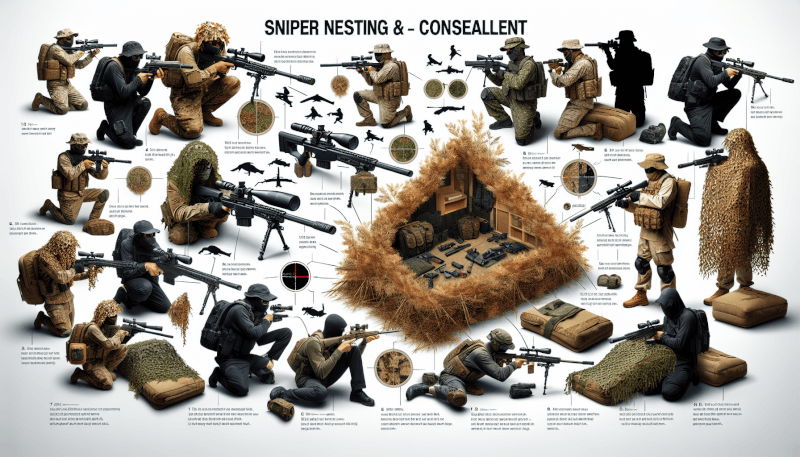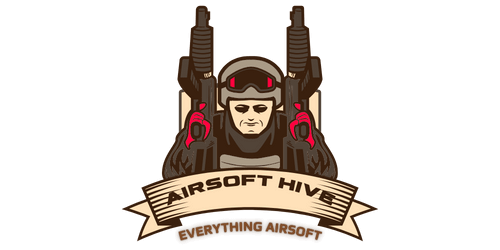Imagine yourself on a thrilling mission, hidden among the shadows, ready to strike. In the exhilarating world of airsoft sniper warfare, mastering the art of nesting and concealment is crucial to success. This in-depth guide will take you on a journey, unveiling the secrets of creating the ultimate hiding spot, blending seamlessly with your environment, and striking fear into the hearts of your opponents. Get ready to become the ultimate stealth sniper, as we unravel the mysteries of airsoft sniper nesting and concealment.
Choosing the Right Location
Surveying the Field
Before setting up your sniper nest, it’s crucial to survey the field and carefully analyze your surroundings. Take note of the terrain, the presence of cover, and potential obstacles that can affect your shooting positions. By doing so, you can identify the best vantage points and make an informed decision about where to set up your nest.
Considering Distance and Terrain
Consider the distance between your nest and potential targets. A good sniper location allows for optimal engagement distances while keeping you concealed. Additionally, take into account the terrain surrounding your chosen shooting position. Look for elevated areas that provide a clear line of sight and advantageous shooting angles.
Finding Elevated Positions
One key aspect of choosing a location is finding elevated positions. Whether it’s a hill, a rooftop, or a tree stand, elevated positions offer a multitude of benefits. They provide a wider field of view, increase your shooting range, and offer better concealment opportunities. Look for natural or man-made structures that can offer a strategic advantage.
Identifying Concealment Opportunities
Concealment is vital for a sniper, as it allows you to remain hidden and avoid detection. Look for natural features such as foliage, bushes, or tree lines that can provide cover and camouflage. Additionally, be aware of man-made objects like buildings or vehicles that can offer concealment options. The key is to blend in seamlessly with your surroundings.
Analyzing Visibility and Lines of Sight
When choosing a location, analyze the visibility and lines of sight that it offers. You need to have a clear view of your intended targets while minimizing the chance of being spotted. Avoid areas that have excessive visual clutter or obstacles that may obstruct your view. A good sniper nest provides a strategic advantage with optimum visibility.
Creating Effective Nesting
Blending In with Surroundings
To create an effective sniper nest, it’s crucial to blend in with your surroundings. Use camouflage patterns and colors that match the environment you’ll be operating in. Take into account the specific terrain, vegetation, and lighting conditions of your chosen location. By blending in effectively, you increase your chances of going undetected.
Using Natural and Artificial Camouflage
Utilize both natural and artificial camouflage techniques to make your nest blend seamlessly with the environment. Make use of natural elements such as branches, leaves, and foliage to create natural hideouts. Additionally, consider using artificial materials like netting or camouflage fabric to further enhance your concealment.
Utilizing Ghillie Suits
Ghillie suits are an invaluable tool for snipers when it comes to hiding and staying concealed. These specialized suits are designed to mimic the natural surroundings and break up the sniper’s silhouette. By wearing a ghillie suit, you can effectively blend in with the environment and make it extremely difficult for the enemy to spot you.
Ensuring Proper Cover
When constructing your sniper nest, it’s essential to ensure proper cover. Use natural or man-made objects to provide physical cover from enemy fire. Position yourself behind rocks, trees, or other structures that can shield you from direct line of sight. Adequate cover will not only keep you safe but also provide additional concealment.
Constructing Hideouts and Fortifications
Consider constructing hideouts and fortifications to further enhance your sniper nest. Create natural or artificial barriers that provide additional protection and concealment. Use sandbags, logs, or any available materials to fortify your position. These hideouts can provide a sense of security and allow you to stay in position for extended periods.

Adjusting Shooting Positions
Accounting for Ranges and Targets
When adjusting your shooting positions, it’s crucial to account for the ranges and targets you’ll be engaging. Optimal shooting positions allow you to effectively engage targets at varying distances. Consider the weapon you’re using, its effective range, and adjust your positions accordingly to maximize accuracy and effectiveness.
Maintaining Mobility and Flexibility
While setting up your sniper nest, it’s important to maintain mobility and flexibility. Choose positions that allow you to quickly change shooting angles and engage different targets. Being able to adapt to changing situations is crucial for a successful sniper. Avoid getting too comfortable in one position and always be prepared to move if necessary.
Ensuring Clear and Unobstructed Views
Clarity of vision is essential for a sniper. Ensure that your shooting position offers clear and unobstructed views of the target area. Remove any foliage or obstructions that may hinder your line of sight and increase the chances of missing a crucial shot. A clear view allows you to assess the situation accurately and take precise shots.
Understanding the Effects of Wind
Wind can significantly affect the trajectory of your shots. Understand and account for the effects of wind when adjusting your shooting positions. Use flags or vegetation to gauge wind direction and strength, and adjust your aim accordingly. By compensating for wind, you increase your chances of hitting your targets accurately.
Minimizing Movement and Noise
A key aspect of adjusting shooting positions is minimizing movement and noise. Smooth and controlled movements are essential to avoid alerting the enemy to your presence. Make slow and deliberate adjustments to your position, keeping movements to a minimum. Additionally, be mindful of any noise you may make, as even the slightest sound can give away your position.
Utilizing Foliage and Natural Elements
Using Tree Canopies and Branches
Take advantage of tree canopies and branches to enhance your concealment. Position yourself strategically in the trees, making sure you’re well-camouflaged and have a clear view of your targets. The foliage can provide excellent cover and break up your silhouette, making it harder for the enemy to spot you.
Blending with Bushes and Shrubs
Bushes and shrubs offer excellent concealment opportunities for snipers. Position yourself within the foliage, ensuring you have a clear line of sight while remaining hidden. Use the dense vegetation to your advantage, making it difficult for the enemy to detect your presence. Choose locations with natural cover and always be aware of any movement in the foliage.
Creating Concealed Nesting Points
Look for natural concealed nesting points, such as depressions in the ground or areas with natural cover. These concealed nesting points offer additional protection and help you blend in seamlessly with the environment. By utilizing these hidden locations, you can increase your chances of going undetected and remain hidden from the enemy.
Employing Rocks and Boulders
Rocks and boulders can provide excellent natural cover for snipers. Positioning yourself behind these obstacles offers physical protection from enemy fire while minimizing your exposure. Additionally, rocks and boulders can be used to break up your silhouette and blend in with the surrounding environment.
Leveraging Grass and Tall Vegetation
Grass and tall vegetation can offer effective concealment for snipers, especially in open areas. Position yourself within the grass, ensuring you’re well-camouflaged and have a clear line of sight. The tall vegetation helps break up your outline and provides cover from prying eyes. Make use of natural elements to your advantage to remain undetected.

Mastering Distance Estimation
Practicing Range Estimation Skills
Mastering distance estimation is crucial for a sniper. Practice regularly to develop your range estimation skills. Use various techniques such as visual estimation, using landmarks as references, or utilizing rangefinders. The more you practice, the more accurate you’ll become in determining distances, leading to improved shot placement.
Identifying Reference Points
Identify reference points in your environment that can help you estimate distances accurately. Look for objects with known dimensions, such as vehicles or buildings, and use them as reference points. By comparing the size of the target with the known dimensions, you can make a reasonably accurate estimation of the distance.
Understanding Optics and Scopes
Understanding the optics and scopes of your sniper rifle is essential for accurate distance estimation. Familiarize yourself with the magnification levels, reticle patterns, and adjustments of your scope. Know how to compensate for bullet drop and windage using the reticle markings. A solid understanding of your optics will greatly aid in determining distances and making precise shots.
Using Mil-Dot and MOA Systems
Utilize Mil-Dot or MOA systems to assist in distance estimation when using a scope. These systems offer a series of dots or hash marks that can help you determine the distance based on the target’s size. By using the proper formula and reticle markings, you can quickly estimate distances and adjust your aim accordingly.
Accounting for Ballistic Trajectories
Take into account the ballistic trajectories of your ammunition when estimating distances. Different rounds have different trajectories and drop rates. Understand the specifics of your ammunition and how it performs at various distances. By accounting for these variables, you can more accurately estimate distances and make the necessary adjustments for accurate shot placement.
Understanding Shot Placement
Targeting Vital Areas
Shot placement is crucial for an effective sniper. Focus on targeting vital areas such as the head, chest, or other high-value targets. These areas offer the greatest chance of incapacitating an enemy combatant quickly and effectively. Prioritize shot placement to maximize the potential impact of each shot.
Aiming for High-Value Targets
When engaging targets, prioritize high-value targets within the enemy’s ranks. High-value targets may include enemy leaders, support personnel, or heavily armed individuals. By targeting these individuals, you can disrupt enemy operations and inflict a significant blow to their morale and effectiveness.
Recognizing Cover and Defense Systems
Be aware of enemy cover and defense systems when choosing your shot placement. Take note of fortified positions, barriers, or other obstacles that may shield the enemy. Identify weak points or areas where the enemy is exposed, allowing you to maximize the effectiveness of your shots and neutralize potential threats.
Minimizing Chances of Friendly Fire
When taking shots as a sniper, it’s crucial to minimize the chances of friendly fire. Ensure you have a clear line of sight on your targets and be aware of your surroundings. Communicate effectively with your team and maintain strict target identification protocols. By doing so, you reduce the risk of inadvertently hitting friendly forces.
Evaluating Potential Collateral Damage
Consider potential collateral damage when selecting your shot placement. Evaluate the area around your target and assess the risks of unintended casualties. Be mindful of civilians or non-combatants within the vicinity and avoid taking shots that could endanger innocent lives. A responsible sniper always considers the broader impact of their actions.

Maintaining Stealth and Concealment
Suppressing Weapon Noise
Maintaining stealth and concealment requires suppressing weapon noise. Attach a suppressor or silencer to your sniper rifle to reduce the distinctive sound of gunfire. The muffled noise helps to mask your position and prevents alerting the enemy.
Employing Silencers and Suppressors
Silencers and suppressors are essential tools for snipers. These devices attach to the muzzle of your rifle and significantly reduce the noise and muzzle flash produced when firing. Using silencers and suppressors enhances your stealth by minimizing the chances of being detected by sound or flash signatures.
Using Proper Shooting Techniques
Proper shooting techniques also play a role in maintaining stealth and concealment. Focus on maintaining a stable shooting platform, controlling your breathing, and using proper trigger control. These techniques help reduce muzzle movement and minimize noise during the shooting process.
Understanding Sound Dampening Tactics
Understanding sound dampening tactics can aid in maintaining stealth and concealment. Be aware of the terrain and its effect on sound propagation. Utilize natural features like hills or walls to help dampen the noise produced when firing. These tactics help to reduce the distance from which your shots can be heard.
Minimizing Visual Cues and Movement
To maintain stealth, minimize any visual cues and movement. Avoid sudden or unnecessary movements that may attract attention. Stay low and use terrain features to your advantage. By being mindful of your actions and minimizing unnecessary movements, you increase your chances of remaining undetected.
Understanding Team Dynamics
Effectively Communicating with Teammates
In a sniper team, effective communication is paramount. Establish clear and concise communication channels with your teammates. Use hand signals or communication devices to relay information quickly and silently. Good communication ensures coordinated actions and enhances the overall effectiveness of your team.
Coordinating with Spotter and Support
Coordinate closely with your spotter and support personnel. The spotter assists the sniper by identifying targets, providing range estimates, and assisting with situational awareness. Maintain constant communication with your spotter to ensure seamless coordination and effective target engagement.
Providing Situational Awareness
As a sniper, part of your role is to provide situational awareness to your team. Share information about enemy movement, potential threats, and changes in the environment. Keeping your teammates informed allows them to make informed decisions and adjust their strategies accordingly.
Maintaining Proper Positioning
Maintain proper positioning within your team’s overall strategy. Understand your role and responsibilities and position yourself accordingly. Whether you’re providing overwatch, executing flanking maneuvers, or acting as a deterrent, being in the right position at the right time greatly contributes to the success of your team.
Executing Flanking and Ambush Strategies
Flanking and ambush strategies can be effective tactics when executed properly. Work closely with your team to plan and execute these maneuvers. Flanking can catch the enemy off guard, while ambushes capitalize on surprise and confusion. By effectively coordinating these strategies, you can effectively neutralize threats and gain a tactical advantage.

Handling Changing Environmental Conditions
Adapting to Varying Weather Conditions
Environmental conditions can significantly impact your sniping operations. Adapt to varying weather conditions by adjusting your shooting positions, ensuring proper cover, and compensating for factors such as wind and moisture. Being adaptable allows you to maintain effectiveness regardless of the environmental circumstances.
Compensating for Light and Shadows
Lighting conditions play a crucial role in sniping operations. Compensate for light and shadows by adjusting your concealment and shooting positions accordingly. Position yourself in areas where shadows and lighting provide maximum concealment. Likewise, be aware of potential glare caused by sunlight reflecting off your optics.
Overcoming Limited Visibility
Limited visibility can pose challenges for snipers. When faced with low-light or foggy conditions, utilize night vision optics or thermal imaging equipment to maintain effective engagement capabilities. Additionally, consider adjusting your shooting positions to maximize your line of sight and minimize the impact of reduced visibility.
Dealing with Rain, Fog, and Wind
Rain, fog, and wind can have a significant impact on sniping operations. Take appropriate measures to deal with these conditions. Ensure your equipment is properly maintained and protected from moisture. Adjust your shooting techniques and compensate for the effects of wind on bullet trajectories. Adapting to these conditions ensures optimal performance as a sniper.
Using Proper Gear and Equipment
Having the right gear and equipment is crucial for handling changing environmental conditions. Invest in quality gear suitable for various weather conditions. Waterproof clothing, thermal blankets, and rangefinders with environmental sensors can all contribute to your ability to adapt to different scenarios. Properly maintaining and utilizing your gear is essential for overcoming environmental challenges.
Practicing Tactical Movement
Mastering Stealthy Approaches
Tactical movement is a fundamental skill for snipers. Mastering the art of stealthy approaches allows you to get close to your target without being detected. Practice moving silently and efficiently, utilizing cover and camouflage to remain hidden. By mastering this skill, you can position yourself for optimal engagement opportunities.
Executing Crawling and Low-Crawling Techniques
Crawling and low-crawling techniques are essential for maintaining a low profile and staying concealed. Practice these techniques to familiarize yourself with moving silently and quickly while remaining close to the ground. Keep your movements deliberate, controlled, and minimize noise to avoid detection.
Understanding Cross-Country Navigation
Understanding cross-country navigation is vital for snipers operating in various landscapes. Familiarize yourself with map reading, compass navigation, and terrain analysis. Develop skills in navigating through challenging environments to reach your intended destinations efficiently and without being detected.
Reacting to Contact and Enemy Encounters
As a sniper, it’s crucial to know how to react when faced with contact or enemy encounters. Follow established protocols for engaging the enemy or evading danger. Maintain calmness, assess the situation, and act accordingly to ensure the safety of yourself and your team.
Retreating and Evading Pursuit
In certain situations, retreating and evading pursuit may become necessary. Develop techniques for effectively retreating and evading pursuers. Utilize cover, camouflage, and unconventional routes to create distance and increase the chances of escaping without being detected.
In conclusion, mastering the art of nesting and concealment is essential for any sniper. Choosing the right location, creating effective nests, adjusting shooting positions, utilizing foliage, understanding distance estimation, shot placement, maintaining stealth, team dynamics, handling changing environmental conditions, and practicing tactical movement are all key components of becoming a successful sniper. By honing these skills and techniques, you can maximize your effectiveness and contribute to the success of your team in any operational scenario.


